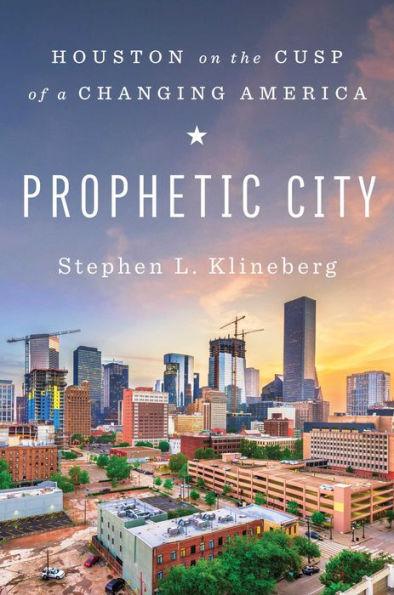
SOCIOLOGY/HOUSTON
Stephen L. Klineberg
Prophetic City: Houston on the Cusp of a Changing America
Avid Reader Press
Hardcover (also available as an e-book, audiobook, and on audio CD), 978-1-5011-7791-0, 336 pgs., $28
June 2, 2020
Prophetic City is a fascinating read from several different perspectives. First, Stephen L. Klineberg has amassed a well-supported and painstakingly researched history of the nation’s fourth-largest city. Moreover, the analysis of the social, ethnic, technological, environmental, and industrial realities of Houston, as Klineberg presents them, form a readily useable lens through which readers can compare the relative successes and failures of every major city in the United States struggling with the contemporary challenges of responsible and effective urban development.
Even if a reader is not a sociologist or an aficionado of urban planning, no worries: Prophetic City is easily accessible and, from the start, intriguing. My first inclination when beginning any nonfiction book is to look to the back pages for references and sources, and Klineberg provides thorough, substantial, and ample quantities of both. This book has—literally—street cred.
Houston, as Klineberg explains, is unique in both its geographic and demographic components, being located in an area of Texas where the major and plentiful natural resources of the state—fossil fuels—meet a natural distribution mode—the Gulf of Mexico. The major-port access allows refined oil to flow out and, at the same time, permits immigration to sustain a largely industrial workforce flowing into the city.
Klineberg’s research traces the historical roots of Houston through the early days into the late twentieth century, to the early eighties where two pivotal elements come together. First, the city’s historically “hands-off” approach to the industrialization of energy refining and distribution, which fueled the city’s rapid and substantial emergence as a financial giant among urban areas, reached its peak. According to Klineberg, the most reliable fuel for Houston’s economic engine had been oil and oil prices, treated by urban planners and leaders with a consistently laissez faire passivity, reached its peak in terms of oil prices and city revenue. Then, the bottom fell out of the oil market, a disaster the city had to resolve.
The second detail is Klineberg’s research: in 1982, Klineberg developed and deployed a boilerplate polling outreach, the “Kinder Houston Area Survey,” to measure both citizens’ beliefs and concerns, basically road-mapping where Houstonian’s priorities lay during the boom times and, surprisingly, the bust that followed the collapse of oil prices shortly after Klineberg began compiling research data. The consistent and continued polling over the course of three decades offers readers a uniquely sourced look at a major-city population’s attitudes against the reality of universal urban challenges like economic opportunity—or the lack—for all demographics, ongoing environmental damage, urban infrastructure decay, immigration, and in Houston’s case, recurring natural disasters like flooding and hurricanes.
Klineberg’s compiled survey results offer both startling and heartening perspective regarding the potential for a major city to resolve divisive and destructive urban challenges successfully. To take but one prominent powder-keg issue—immigration—Klineberg offers a detailed readout of Houston’s pulse as the challenge unfolded. Charted documentation underscores Klineberg’s finding that the shift in immigration from primarily European people to mostly non-European immigrants that affected Houston, like every major American city, beginning in 1962, was more successfully handled by Houston than perhaps any other major American city. Klineberg describes sociological laissez faire regarding Houston’s Asian American population seemingly spontaneously stepping up unbidden and addressing much of the immigrant homelessness through sharing of both real estate and resources, totally independent of municipal government.
Similar internal, voluntary resources and the willpower of a diverse yet cohesive population, helped Houston surmount the challenges of recurring natural disasters as well as the fluctuations in the energy revenues that continue to be the lifeblood of the city.
If there is one weakness in the book, it would be Klineberg’s shift from what is primarily an academic or even journalistic mode into personal narrative: his pre-Houston childhood, his wife’s unrelated academic employment, his personal relationships with prominent figures, seems only to distract and diffuse. The text is at its best in the mainly journalistic reporting of the long-term study, the polling results, and the remarkable adaptation of megalopolis Houston to the modern challenges other American cities struggle with as well, but with less success.
This book will appeal to both Texas historians seeking a fresh and informative perspective not only on Houston itself, but on the potential of every major urban area in the country facing similar challenges. The writing is clean and engaging, the documentation and sourcing impeccable. Prophetic City is a unique, thought-provoking, and worthwhile read.
Stephen Klineberg, a graduate of Haverford College, with an MA from the University of Paris and a PhD from Harvard, is the founding director of the Kinder Institute for Urban Research, a multi-disciplinary “think-and-do tank” housed on the Rice University campus in central Houston, working to advance understanding of the most important issues facing Houston and other leading urban centers. Klineberg joined Rice University’s Sociology Department in 1972, and in 1982 he and his students initiated the annual Houston Area Survey, now in its thirty-eighth year of tracking the remarkable changes in the demographic patterns, economic outlooks, experiences, attitudes, and beliefs of Harris County residents.
